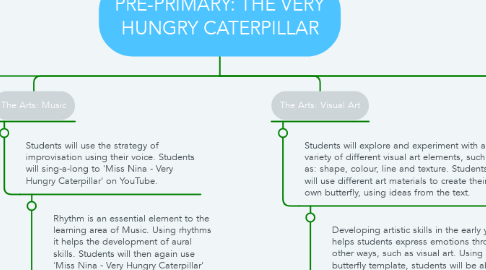
1. English
1.1. LANGUAGE: Students should have an understanding that punctuation is a written feature of text and can include: capital letters, full stops, etc. Using the text, students will identify the punctuation within the text, and look at why we must use punctuation within our writing.
1.1.1. LANGUAGE: Students should have knowledge about print and the characteristics and feature of print inside a text. For this text, students will look at reading the text the correct way. Starting at the cover page and reading from left to right.
1.1.1.1. LANGUAGE: Students should have the ability to recognise that sentences are a key unit within a text for expressing ideas to the readers. Students will look closely at the text and the sentences used to form the story. Students will look at the beginning, middle and end of the story.
1.1.1.1.1. LITERATURE: Students will share and express their feelings and thoughts about the events, characters and plot about the text. This will be completed as a whole class activity through a discussion. Students will have the opportunity to share their thoughts and opinions on the text.
2. Mathematics
2.1. Students should have an understanding of number names. Students will connect number names, numerals and quantities, including zero, initially up to 10 and then beyond. Students will use number sentences from the text: "2 pears, 3 plums, 4 strawberries, etc."
2.1.1. Students should have the ability to present practical situations to model addition and sharing. Students will use number sentences from the text for this activity. "The caterpillar ate 2 pears, and 3 plums. How much fruit did he eat all together?"
2.1.1.1. Students should have the ability to sort and classify objects. They should have knowledge on how to create and continue patterns. During this activity, students will be given objects similar to the fruits in the text: apples, pears, plums, strawberries, oranges, etc. With these objects, in small groups, students will make their own patters with one another.
3. The Arts: Visual Art
3.1. Students will explore and experiment with a variety of different visual art elements, such as: shape, colour, line and texture. Students will use different art materials to create their own butterfly, using ideas from the text.
3.1.1. Developing artistic skills in the early years, helps students express emotions through other ways, such as visual art. Using a large butterfly template, students will be able to decorate this as a whole class, using elements such as: colour and texture. Materials will be provided to the students to decorate this. It will be a whole-class activity, promoting collaboration with one another.
3.1.1.1. Following the previous activity. The butterfly will be placed upon the front of the class for all students to sit. Students will respond to the feelings they had about this artwork and how they felt about working with one another.
4. Science
4.1. Living things have needs. Students will looks at the idea that every living thing have basic needs, including food and water. Students will then go on to look at the basic needs a caterpillar has. Looking specifically at what they need to go grow into a butterfly.
4.1.1. Science involves observing changes in objects and events, including life events. In this activity, students will focus on the life cycle. How it starts as a caterpillar and then evolves into a butterfly.
4.1.1.1. Animals often have have seasonal changes, where they are most active in one particular season. Students will look at butterflies and caterpillars, and observe what seasons where they are most active.
5. The Arts: Music
5.1. Students will use the strategy of improvisation using their voice. Students will sing-a-long to 'Miss Nina - Very Hungry Caterpillar' on YouTube.
5.1.1. Rhythm is an essential element to the learning area of Music. Using rhythms it helps the development of aural skills. Students will then again use 'Miss Nina - Very Hungry Caterpillar' on YouTube and make their own beat and rhythms with the materials that have been provided to them.
5.1.1.1. Following the previous activity. Students should have the ability to demonstrate audience behaviour and being an attentive listener to other performances. Once the YouTube clip is over, students will have the opportunity to display their own music rhythm to class. Each student will have their own turn and demonstrating this. Other students will try copy with their own musical instrument.
